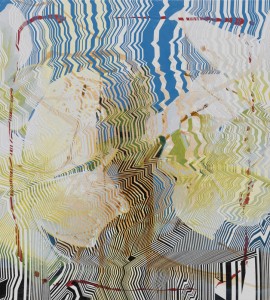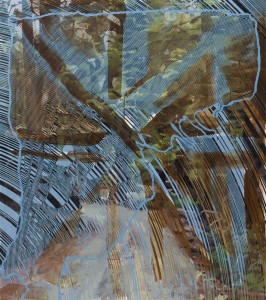Sharne Wolff discovers that in James Cousin’s painting process is just as important as outcome…
James Cousins may not exactly be a household name in Australia – yet – but he’s been exhibiting work regularly in his home country of New Zealand since the mid 1990’s. Cousins most recent show in New Zealand entitled Signal was shown at Gow Langsford Gallery in Auckland.
James Cousins, Untitled (Stem). Oil and acrylic on canvas. 1050 x 950cm
This new exhibition entitled Front Load recently opened at Ryan Renshaw Gallery in Brisbane. Renshaw has had his eye on bringing some New Zealand talent to Brisbane for some time and an introduction through a friend at the Institute of Modern Art suggested Cousins might be just the kind of artist that could work well in Renshaw’s space. Although this is a not a large exhibition of Cousins’ work, it’s great to see a relatively small gallery like this hosting a show for some new work from across the Tasman.
The images in the show comprise a series of oil and acrylics on canvas all officially titled ‘Untitled’ but each with an added descriptive term to make it a little easier to distinguish one from another. It is quite evident when viewing the pictures they are painted in layers – for Cousins the process of making the works is just as important (if not more so) than the appearance of the finished canvas. The process used is quite complex and involves several time-consuming stages. In simple terms (I hope I get this right) this includes the application of a base layer of paint washed over the canvas and then the making of a contour-like ‘map’ the same size as the canvas fashioned from either a found image or the base layer itself. The process of making the map is possibly the most difficult and the most interesting part of the process – the map is then cut in stencil-like fashion and the resulting template placed over the base layer of paint. It is then painted over once more – generally with a realistically rendered landscape. A tension is created between the spontaneity of the work on the one hand and the use of fine-tuned technology on the other.
James Cousins, Untitled (Road). Oil and acrylic on canvas. 1700 x 1500cm.
The artist tells me that the landscapes used are based on found photographs sourced from magazines or elsewhere. They are deliberately chosen for their banality. The forest in Untitled (Clearing) or the flowers in Untitled (Stem) could derive from any place, anywhere. Sometimes Cousins uses the same landscape in different works. Although the specific is insignificant, the recognisability of it as something ‘real’ is an important part of making these pictures work.
The final part of the process is the ‘unmaking’ of the picture by removing part of the template to reveal the artwork. This is the tricky bit – but I imagine the most rewarding for the artist. What the process of stripping back reveals must be almost as much of a surprise for Cousins as it is for the viewer. There can be no total control. Although fracturing the image below, the stencil creates a completely new work – geometric patterns, sweeping circles and dramatic bold lines and angles animate the surface. In some of the works like Untitled (Blue) the work has been further ‘unmade’ – the stencil has been rubbed over while the paint is still wet and it is barely evident. In other works like (Untitled (Road)) more paint has been applied to the surface.
As well as the fractured image, design and colour play a big part in these works. In Untitled Stem and Untitled Blue and others, the mapped layer creates the importance of colour. In Untitled Clearing, it’s the colour of the base layer that emerges with more strength.
When viewing these pictures, the eye is distracted. It’s hard to know what you are looking at. What does the artist want me to see? Being forced to ask these questions of you as a viewer is, I think, exactly what the artists wants. On the one hand the canvases represent a construction by the artist but he is never in complete control of the outcome. When you look at the pictures you can’t be sure if you are looking at a representation or an abstract image. In any case, we are forced to look at the pictures as ‘art’ and perhaps that is what makes them interesting.
James Cousins Front Load
Ryan Renshaw Gallery, Brisbane
Until 23 April 2011



James Cousins Front Load has now been extended until Saturday 30 April.
We are also open to the public on Saturday 23 April.
Kind regards
Ryan Renshaw Gallery
James Cousins Front Load has now been extended until Saturday 30 April.